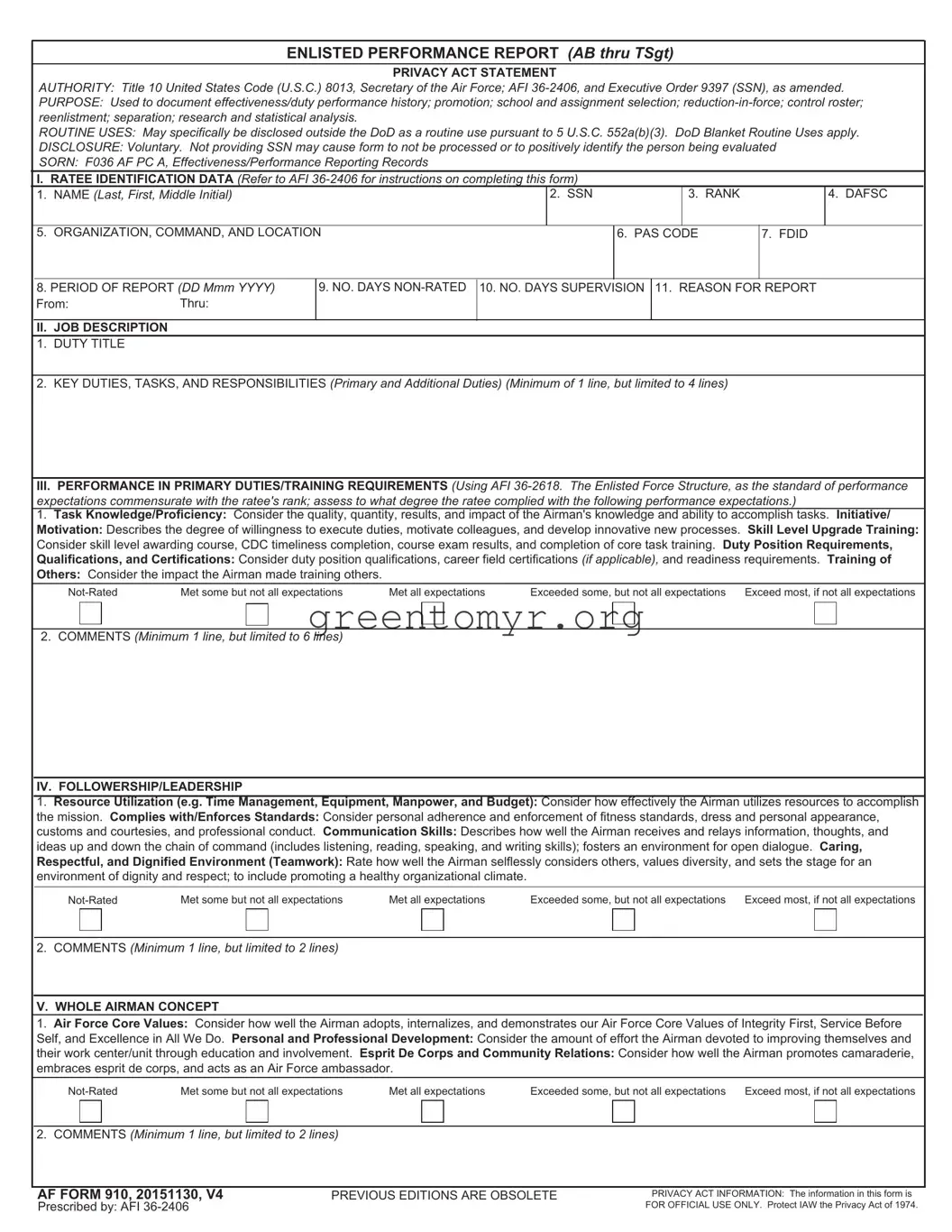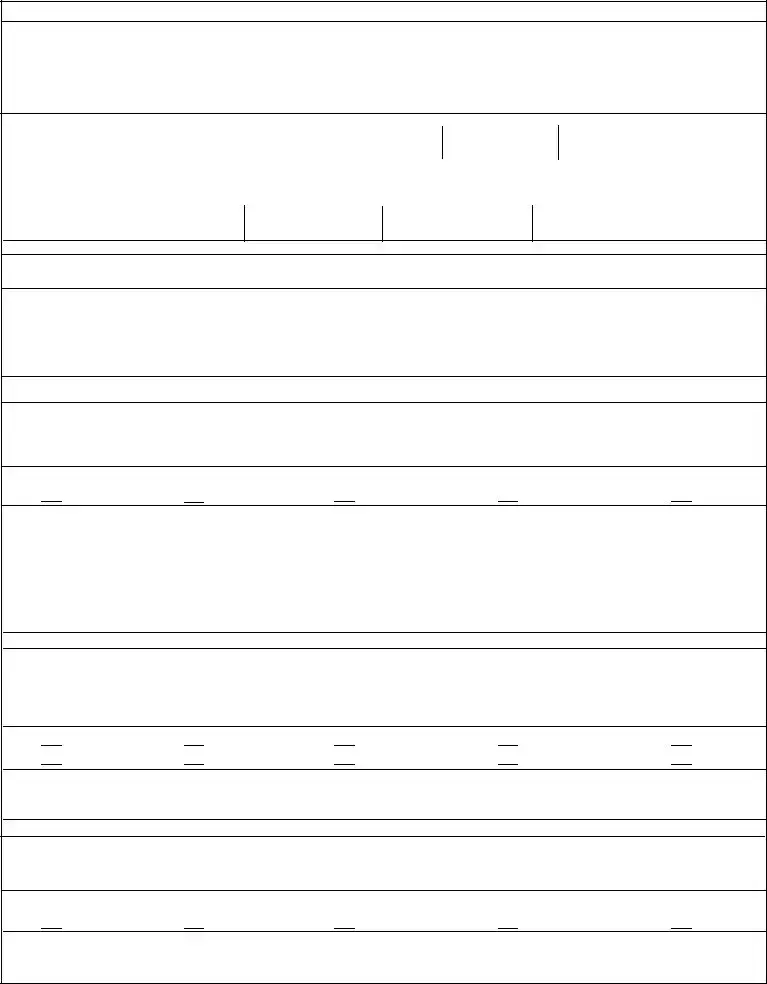ENLISTED PERFORMANCE REPORT (AB thru TSgt)
PRIVACY ACT STATEMENT
AUTHORITY: Title 10 United States Code (U.S.C.) 8013, Secretary of the Air Force; AFI 36-2406, and Executive Order 9397 (SSN), as amended.
PURPOSE: Used to document effectiveness/duty performance history; promotion; school and assignment selection; reduction-in-force; control roster; reenlistment; separation; research and statistical analysis.
ROUTINE USES: May specifically be disclosed outside the DoD as a routine use pursuant to 5 U.S.C. 552a(b)(3). DoD Blanket Routine Uses apply.
DISCLOSURE: Voluntary. Not providing SSN may cause form to not be processed or to positively identify the person being evaluated
SORN: F036 AF PC A, Effectiveness/Performance Reporting Records
I.RATEE IDENTIFICATION DATA (Refer to AFI 36-2406 for instructions on completing this form)
|
1. |
NAME (Last, First, Middle Initial) |
|
2. SSN |
3. |
RANK |
|
4. DAFSC |
|
|
|
|
|
|
I |
I |
|
|
I |
|
|
5. |
ORGANIZATION, COMMAND, AND LOCATION |
|
6. PAS CODE |
|
7. FDID |
|
|
|
|
|
|
|
|
|
|
8. PERIOD OF REPORT (DD Mmm YYYY) |
9. NO. DAYS NON-RATED |
10. NO. DAYS SUPERVISION |
11. REASON FOR REPORT |
|
From: |
Thru: |
I |
I |
I |
|
|
|
|
|
|
|
|
|
|
|
|
II.JOB DESCRIPTION
1. DUTY TITLE
2.KEY DUTIES, TASKS, AND RESPONSIBILITIES (Primary and Additional Duties) (Minimum of 1 line, but limited to 4 lines)
III.PERFORMANCE IN PRIMARY DUTIES/TRAINING REQUIREMENTS (Using AFI 36-2618. The Enlisted Force Structure, as the standard of performance expectations commensurate with the ratee's rank; assess to what degree the ratee complied with the following performance expectations.)
1. Task Knowledge/Proficiency: Consider the quality, quantity, results, and impact of the Airman's knowledge and ability to accomplish tasks. Initiative/
Motivation: Describes the degree of willingness to execute duties, motivate colleagues, and develop innovative new processes. Skill Level Upgrade Training: Consider skill level awarding course, CDC timeliness completion, course exam results, and completion of core task training. Duty Position Requirements, Qualifications, and Certifications: Consider duty position qualifications, career field certifications (if applicable), and readiness requirements. Training of Others: Consider the impact the Airman made training others.
Not-Rated |
Met some but not all expectations |
Met all expectations |
Exceeded some, but not all expectations |
Exceed most, if not all expectations |
|
□ |
|
|
|
□ |
|
|
|
□ |
|
|
|
|
□ |
|
|
|
□ |
|
|
|
|
|
|
|
|
|
|
|
2. COMMENTS (Minimum 1 line, but limited to 6 lines) |
|
|
|
|
|
|
|
|
|
|
|
|
|
IV. FOLLOWERSHIP/LEADERSHIP
1.Resource Utilization (e.g. Time Management, Equipment, Manpower, and Budget): Consider how effectively the Airman utilizes resources to accomplish the mission. Complies with/Enforces Standards: Consider personal adherence and enforcement of fitness standards, dress and personal appearance, customs and courtesies, and professional conduct. Communication Skills: Describes how well the Airman receives and relays information, thoughts, and ideas up and down the chain of command (includes listening, reading, speaking, and writing skills); fosters an environment for open dialogue. Caring, Respectful, and Dignified Environment (Teamwork): Rate how well the Airman selflessly considers others, values diversity, and sets the stage for an environment of dignity and respect; to include promoting a healthy organizational climate.
Not-Rated |
Met some but not all expectations |
Met all expectations |
Exceeded some, but not all expectations |
Exceed most, if not all expectations |
□
 □
□
 □
□
 □
□
 □
□

2.COMMENTS (Minimum 1 line, but limited to 2 lines)
V. WHOLE AIRMAN CONCEPT
1.Air Force Core Values: Consider how well the Airman adopts, internalizes, and demonstrates our Air Force Core Values of Integrity First, Service Before Self, and Excellence in All We Do. Personal and Professional Development: Consider the amount of effort the Airman devoted to improving themselves and their work center/unit through education and involvement. Esprit De Corps and Community Relations: Consider how well the Airman promotes camaraderie, embraces esprit de corps, and acts as an Air Force ambassador.
Not-Rated |
Met some but not all expectations |
Met all expectations |
Exceeded some, but not all expectations |
Exceed most, if not all expectations |
|
□ |
|
|
□ |
|
|
□ |
|
|
□ |
|
|
□ |
|
|
|
|
|
|
|
|
|
|
|
2. COMMENTS (Minimum 1 line, but limited to 2 lines) |
|
|
|
|
|
|
|
|
|



 □
□
 □
□
 □
□
 □
□

